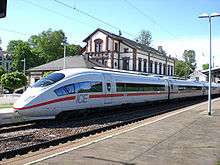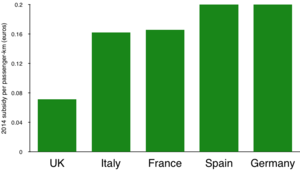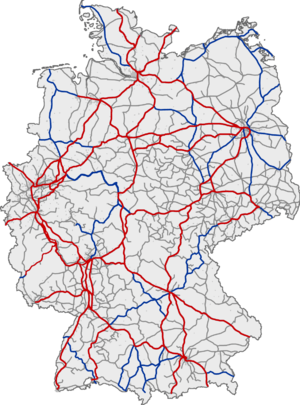Rail transport in Germany
| Germany | |||||
|---|---|---|---|---|---|
 An ICE 3 at St. Ingbert | |||||
| Operation | |||||
| National railway | Deutsche Bahn | ||||
| Statistics | |||||
| Ridership | 2.02 billion (2013, Deutsche Bahn only)[1] | ||||
| Passenger km | 82.4 billion (2012, Deutsche Bahn only)[2] | ||||
| Freight | 105.9 billion tkm (2012, Deutsche Bahn only)[2] | ||||
| System length | |||||
| Total | 41,315 kilometres (25,672 mi) [3] | ||||
| Double track | 18,201 kilometres (11,310 mi) | ||||
| Electrified | 19,857 kilometres (12,339 mi) | ||||
| Track gauge | |||||
| Main | 1,435 mm (4 ft 8 1⁄2 in) | ||||
| Electrification | |||||
| 15 kV 16 2/3 Hz | Main network | ||||
| |||||
As of 2005, Germany had a railway network of 41,315 km of which 34,211 km belonged to the national railway and 19,857 km were electrified, 18,201 km with double track.[4] The total track length was 76,473 km. Germany is a member of the International Union of Railways (UIC). The UIC Country Code for Germany is 80.
Overview
There are around 23,500 powered rail vehicles in Germany, operated by the main operator Deutsche Bahn as well as around 1,500 smaller private railway companies:[5]
| Passenger transport | Goods | Sum | ||
|---|---|---|---|---|
| Long-distance | Short-distance | |||
| Multiple units | 538 | 15,224 | 0 | 15,762 |
| Locomotives | 2,650 | 1,950 | 3,134 | 7,734 |
| Sum | 3,188 | 17,174 | 3,134 | 23,496 |
In 2006, railways in Germany carried around 119,968,000 passengers on long-distance trains (at an average distance of 288 km), and 2,091,828,000 passengers on short-distance trains (21 km on average). In the same year they carried 346,118,000 tonnes of goods at an average distance of 309 km.[6]

Deutsche Bahn (state-owned private company) is the main provider of railway service. In recent years a number of competitors have started business. They mostly offer state-subsidized regional services, but some, like Veolia Verkehr offer long-distance services as well.
- Deutsche Bahn – long distance trains
- Intercity-Express – high speed train, largely national but some routes to the Netherlands, Belgium, Switzerland, Austria, France and Denmark
- EuroCity – international long-distance trains
- Intercity – national long-distance trains
- EuroNight – international night trains
- DB NachtZug – national and international night trains
- UrlaubsExpress – national night trains to the Alps and the Baltic Sea during vacation times
InterRegio services, introduced in 1988 to replace the former Schnellzug and Intercity, were abolished in 2003. Deutsche Bahn is gradually increasing the percentage of InterCityExpress services, and downgrading the remaining InterCity services to the role formerly played by InterRegio.
- Veolia Verkehr – offers services on certain former Interregio routes
- Thalys – high-speed services to Belgium and France, using modified French TGV trains
- Cisalpino – to Italy, service discontinued mid-December 2006
- Regional rail and local rail traffic is organised and subsidised (as the fares usually do not cover the running costs) by the federal states. Usual procedure under EU legislation is to award the contract to the lowest bid by means of a tender procedure. The respective states are free to announce short- or long-term contracts as well as to stipulate further conditions e.g. on rolling stock. In recent years, many bids were won by private rail companies like NordWestBahn or Arriva, although some states have awarded long-term contracts to local DB Regio subsidiaries. The train types for regional and local traffic are:
- Regional-Express and Interregio-Express – medium-distance semi-fast trains for regional services
- Regionalbahn – basic local service, usually calling at all stations
- S-Bahn – suburban rail services mostly provided by Deutsche Bahn
- U-Bahn – underground train services provided by the various cities' transport bodies (not Deutsche Bahn)
- Tram/light rail services; in a few major cities these run underground in the city centre (often called "Stadtbahn", especially if they have been upgraded to railway standards)
History
German Railway history began with the opening of the steam-hauled Bavarian Ludwig Railway between Nuremberg and Fürth on 7 December 1835. The first long distance railway was the Leipzig-Dresden railway, completed on 7 April 1839. The following years saw a rapid growth: By the year 1845, there were already more than 2,000 km of railroads in Germany, ten years later that number was above 8,000.
German unification in 1871 stimulated consolidation, nationalization into state-owned companies, and further rapid growth.[7] Unlike the situation in France, the goal was support of industrialization, and so heavy lines crisscrossed the Ruhr and other industrial districts, and provided good connections to the major ports of Hamburg and Bremen. By 1880, Germany had 9,400 locomotives pulling 43,000 passengers and 30,000 tons of freight, and forged ahead of France.[8]
During the Second World War, austere versions of the standard locomotives were produced to speed up construction times and minimise the use of imported materials. These were the so-called war locomotives (Kriegslokomotiven and Übergangskriegslokomotiven). Absent a good highway network and trucks, the Germans relied heavily on the railways, supplemented by slower river and canal transport for bulk goods.[9]
In 1989, the Berlin Wall fell. Train frequency rapidly increased on the existing East/West corridors; closed links which had formerly crossed the border were re-opened. On 3 October 1990, Germany was reunified; however, this was not immediately the case with the railways. Administrative and organisational problems led to the decision to completely re-organise and reconnect Germany's railways. The so-called Bahnreform (Railway Reform) came into effect on 1 January 1994, when the State railways Deutsche Bundesbahn and Deutsche Reichsbahn were formally reunited to form the current German Railway Corporation (Deutsche Bahn).[10]
The German railways were long protected from competition from intercity buses on journeys over 50 km. However, in 2013, this protection was removed,[11] leading to a significant shift from rail to bus for long journeys.[12]
Track gauges
| Gauge | Country/region | Companies | Notes | ||
|---|---|---|---|---|---|
| name | metric (mm) | imperial | |||
| Irish gauge | 1,600 | 5 ft 3 in | Germany | Grand Duchy of Baden State Railway 1840–1855[13] | |
| Russian gauge | 1,520 | 4 ft 11 5⁄6 in | Germany | Only at Sassnitz/Mukran ferry terminal for freight train ferries to Klaipėda and Baltijsk, Kaliningrad Oblast, a Russian exclave between Poland and Lithuania on the Baltic Sea. | |
| Standard gauge | 1,435 | 4 ft 8 1⁄2 in | Germany | Deutsche Bahn | This is the standard or international gauge |
| Metre gauge | 1,000 | 3 ft 3 3⁄8 in | Germany | Harz Narrow Gauge Railways, trams | |
| 1,800 | 5 ft 10 7⁄8 in | Oberweißbacher Bergbahn (funicular section only)[13] | |||
| 1,458 | 4 ft 9 2⁄5 in | Leipziger Verkehrsbetriebe AG | |||
| 1,450 | 4 ft 9 1⁄5 in | Dresdner Verkehrsbetriebe AG | |||
| 900 | 2 ft 11 7⁄16 in | Mecklenburgische Bäderbahn Molli | |||
| 750 | 2 ft 5 1⁄2 in | Lößnitzgrundbahn; Weißeritztalbahn; Döllnitzbahn GmbH; Zittauer Schmalspurbahn | |||
Platform height

The European Union Commission issued a TSI (Technical Specifications for Interoperability) on 30 May 2002, (2002/735/EC) that sets out standard platform heights for passenger steps on high-speed rail. These standard heights are 550 mm and 760 mm.[14][note 1]
In Germany new builds are 550 mm and 760 mm. Mecklenburg-Vorpommern has new builds with 550 mm.[16] Hesse, NRW, Berlin had new builds with 760 mm.[16]
Rail links to adjacent countries
All these links are to countries of the same gauge, although electrification and other systems (such as signalling) may differ.
- Denmark — voltage change to 25 kV AC
- Poland — voltage change to 3 kV DC
- Czech Republic — voltage change to 3 kV DC
- Austria — same voltage (15 kV AC, 16.7 Hz)
- Switzerland — same voltage
- France — voltage change to 25 kV AC (no direct connection to France's 1500 V DC network)
- Luxembourg— voltage change to 25 kV AC or 3 kV DC
- The Netherlands — voltage change to 1500 V DC
- Betuweroute voltage change to 25 kV AC - freight only
- Belgium — voltage change to 3 kV DC
International passenger trains
- Amsterdam Centraal — Berlin Ostbahnhof
- Amsterdam Centraal — Frankfurt / Basel
- Amsterdam Centraal — Munich Hbf — Innsbruck Hbf, night train (City Night Line)
- Amsterdam Centraal — Berlin Hbf — Prague / Warsaw, night train (EuroNight)
- Amsterdam Centraal — Frankfurt Hbf — Basel Bad Bf — Zürich HB — Brig-Glis, night train (City Night Line)
- Copenhagen Hovedbanegarden — Hamburg Hbf
- Copenhagen Hovedbanegarden — Basel / Amsterdam Centraal, night train (City Night Line)
- Novosibirsk/Astana/Moscow/Saint Petersburg/Kharkiv — Berlin Lichtenberg
- Berlin — Prague Holešovice
- Frankfurt am Main — Strasbourg/Basel
- Munich — Verona
It is also possible to travel to London, United Kingdom by changing onto the Eurostar at Brussels.
Railway subsidies

German rail subsidies amounted to €17.0 billion in 2014,[17] and in 2013, 59% of the cost of short-distance passenger rail transport was covered by subsidies, although subsidies are generally not paid in the long-distance market.[18]
See also
- Rail transport by country
- Rail transport in Europe
- Transport in Germany
- History of rail transport in Germany
- German locomotive classification
Notes
- ↑ In reference to EU documentation on interoperability of trans-national high speed rail (see EU Directive 96/48/EC) platform height is measured from the top of the running surface of the rail.[15]
References
- ↑ http://www.railjournal.com/index.php/financial/rising-costs-and-bad-weather-hit-db-revenues.html?channel=542
- 1 2 deutschebahn.de: Fahrgastrekord in den Zügen der Deutschen Bahn Deutsche Bahn AG
- ↑ The World Factbook: Country Comparison :: Railways
- ↑ http://ilcad.uic.org/IMG/pdf/synopsis_2014.pdf
- ↑ Federal Statistical Office of Germany, Fachserie 8, Reihe 2.1: Verkehr, Eisenbahnverkehr/Betriebsdaten des Schienenverkehrs 2006
- ↑ Federal Statistical Office of Germany, Fachserie 8, Reihe 2: Verkehr, Eisenbahnverkehr 2006
- ↑ by Colleen A. Dunlavy, Politics and Industrialization: Early Railroads in the United States and Prussia (1994).
- ↑ Allan Mitchell, Great Train Race: Railways and the Franco-German Rivalry, 1815-1914 (2000)
- ↑ Alfred C. Mierzejewski, The most valuable asset of the Reich. A history of the German National Railway: Vol 1: 1920-1932 (1999); Vol 2: 1933-1945 (2000)
- ↑ Lutz, Friedrich; Lange, Bernd & Müller, Matthias (2003). "DB launches new locomotive strategy". International Railway Journal. 43 (11): 42.(subscription required)
- ↑ http://www.young-germany.de/topic/live/travel-location/derailing-the-train-how-intercity-buses-are-changing-the-way-we-travel-in
- ↑ http://www.forbes.com/sites/oliverwyman/2015/10/20/european-bus-upstarts-snatch-20-of-passengers-from-rail/2/
- 1 2 Rieger, Bernhard (2006-04-23). "Breitspurbahn". Retrieved 2007-11-29.
- ↑ 2002/735/EC , sections 7.3.4 and 4.2.5
- ↑ "Commission Recommendation of 21 March 2001 on the basic parameters of the trans-European high-speed rail system referred to in Article 5(3)(b) of Directive 96/48/EC". eur-lex.europa.eu. European Union. 21 March 2001. section 6.1.
Platform height is measured between the track running surface and the platform surface along the perpendicular
- 1 2 http://www.pro-bahn.de/pbz/articles/104_barriere.pdf
- ↑ "German Railway Financing" (PDF). p. 2.
- ↑ "Market Analysis: German Railways 2014" (PDF).
External links
| Wikimedia Commons has media related to Rail transport in Germany. |
| Wikivoyage has a travel guide for Rail travel in Germany. |
